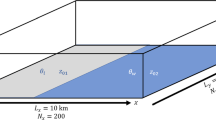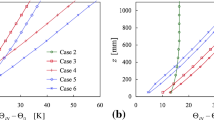Abstract
The impact of coupling the atmosphere to the surface energy balance is examined for the stable boundary layer, as an extension of the first GABLS (GEWEX Atmospheric Boundary-Layer Study) one-dimensional model intercomparison. This coupling is of major importance for the stable boundary-layer structure and its development because coupling enables a realistic physical description of the interdependence of the surface temperature and the surface sensible heat flux. In the present case, the incorporation of a surface energy budget results in stronger cooling (surface decoupling), and a more stable and less deep boundary layer. The proper representation of this is a problematic feature in large-scale numerical weather prediction and climate models. To account for the upward heat flux from the ice surface beneath, we solve the diffusion equation for heat in the underlying ice as a first alternative. In that case, we find a clear impact of the vertical resolution in the underlying ice on boundary-layer development: coarse vertical resolution in the ice results in stronger surface cooling than for fine resolution. Therefore, because of this impact on stable boundary-layer development, the discretization in the underlying medium needs special attention in numerical modelling studies of the nighttime boundary layer. As a second alternative, a bulk conductance layer with stagnant air near the surface is added. The stable boundary-layer development appears to depend heavily on the bulk conductance of the stagnant air layer. This result re-emphasizes the fact that the interaction with the surface needs special attention in stable boundary-layer studies. Furthermore, we perform sensitivity studies to atmospheric resolution, the length-scale formulation and the impact of radiation divergence on stable boundary-layer structure for weak windy conditions.
Similar content being viewed by others
References
Andre J.C. and Mahrt L. (1982). ‘The Nocturnal Surface Inversion and Influence of Clear-air Radiative Cooling’. J. Atmos. Sci. 39: 864–878
Beare, R. J., MacVean, M. K., Holtslag, A. A. M., Cuxart, J., Golaz, J. C., Jimenez, M. A., Khairoutdinov, M., Kosovic, B., Lewellen, D., Lund, T. S., Lundquist, J. K., McCabe, A., Moene, A. F., Noh, Y., Raasch S., and Sullivan, P. P.: 2006 , ‘An Intercomparison of Large-eddy Simulations in the Stable Boundary-Layer’. Boundary-Layer Meteorol., in press.
Beljaars A.C.M. and Holtslag A.A.M. (1991). ‘Flux Parameterization over Land Surfaces for Atmospheric Models’. J. Appl. Meteorol. 30: 327–341
Beljaars A.C.M. and Bosveld F.C. (1997). ‘Cabauw Data for Validation of Land Surface Parametrization Schemes’. J. Climate 10: 1172–1193
Beljaars A.C.M. and Viterbo P. (1998). ‘Role of the Boundary Layer in a Numerical Weather Prediction Model’. In: (eds) Clear and Cloudy Boundary Layers, pp 372. Royal Netherlands Academy of Arts and Sciences, Amsterdam
Best M.J. (1998). ‘A Model to Predict Surface Temperatures’. Boundary-Layer Meteorol 88: 279–306
Beyrich F. (1997). ‘Mixing Height Estimation from Sodar Data- A Critical Discussion’. Atmos. Environ. 31: 3941–3953
Beyrich F., Meijninger W.M.L., Schipper J.W., Lohse H. and Bruin H.A.R. (2002). ‘Results from One-Year Continuous Operation of a Large Aperture Scintillometer over a Heterogeneous Land Surface’. Boundary-Layer Meteorol. 105: 85–97
Brost R.A. and Wyngaard J.C. (1978). ‘A Model Study of the Stably Stratified Planetary Boundary Layer’. J. Atmos. Sci. 35, 1427–1440.
Bruin H.A.R. (1994). ‘Analytic Solutions of the Equations Governing the Temperature Fluctuation Method’. Boundary-Layer Meteorol 68: 427–432
Coulter R.L. and Doran J.C. (2002). ‘Spatial and Temporal Occurrences of Intermittent Turbulence during CASES-99’. Boundary-Layer Meteorol. 105: 329–349
Cuxart J., Yagüe C., Morales G., Terradellas E., Orbe J., Calvo J., Fernández A., Soler M.R., Infante C., Buenestado P., Espinalt A., Joergensen H.E., Rees J.M., Vilà J., Redondo J.M., Cantalapiedra I.R. and Conangla L. (2000). ‘Stable Atmospheric Boundary-Layer Experiment in Spain (SABLES 98): A Report’. Boundary-Layer Meteorol. 96: 337–370
Cuxart, J., Holtslag, A. A. M., Beare, R. J., Bazile, E., Beljaars, A. C. M., Cheng, A., Conangla, L., Ek, M., Freedman, F., Hamdi, R., Kerstein, A., Kitagawa, H., Lenderink, G., Lewellen, D., Mailhot, J., Mauritsen, T., Perov, V., Schayes, G., Steeneveld, G. J., Svensson, G., Taylor, P. A., Weng, W., Wunsch, S., and Xu, K.-M.: 2006, ‘A Single-Column Model Intercomparison for a Stably Stratified Atmospheric Boundary Layer’, Boundary-Layer Meteorol., in press.
Delage Y. (1974). ‘A Numerical Study of the Nocturnal Atmospheric Boundary-Layer’. Quart. J. Roy. Meteorol. Soc. 100: 351–364
Delage Y. (1997). ‘Parameterising Sub-grid Scale Vertical Transport in Atmospheric Models Under Statically Stable Conditions’. Boundary-Layer Meteorol. 82: 23–48
Delage Y., Barlett P.A. and McCauchy J.H. (2002). ‘Study of ‘Soft’ Night Time Surface Layer Decoupling over Forest Canopies in a Land-Surface Model’. Boundary-Layer Meteorol. 103: 253–276
Derbyshire S.H. (1999). ‘Boundary-layer Decoupling over Cold Surfaces as a Physical Boundary Instability’. Boundary-Layer Meteorol. 90: 297–325
Duynkerke P.G. (1991). ‘Radiation Fog: A Comparison of Model Simulation with Detailed Observations’. Mon. Wea. Rev. 119: 324–341
Duynkerke P.G. (1999). ‘Turbulence, Radiation and Fog in Dutch Stable Boundary-Layers’. Boundary-Layer Meteorol. 90: 447–477
Estournel C. and Guedalia D. (1985). ‘Influence of Geostrophic Wind on Atmospheric Nocturnal Cooling’. J. Atmos. Sci. 42: 2695–2698
Galmarini S., Beets C., Duynkerke P.G. and Vila-Gueraude Arellano J. (1998). ‘Stable Nocturnal Boundary-layers: a Comparison of One-dimensional and Large-eddy Simulation Models’. Boundary-Layer Meteorol. 88: 181–210
Garratt J.R. and Brost R.A. (1981). ‘Radiative Cooling Effects within and above the Nocturnal Boundary-Layer’. J. Atmos. Sci. 38: 2730–2746
Ha K.J. and Mahrt L. (2003). ‘Radiative and Turbulent Fluxes in the Nocturnal Boundary-Layer’. Tellus 55A: 317–327
Holtslag A.A.M. and Bruin H.A.R. (1988). ‘Applied Modelling of the Nighttime Surface Energy Balance over Land’. J. Appl. Meteorol. 27: 689–704
Holtslag A.A.M (1998). Modeling of Atmospheric Boundary Layers. In: Holtslag, A.A.M. and Duynkerke, P.G. (eds) Clear and Cloudy Boundary Layers, pp 372. Royal Netherlands Academy of Arts and Sciences, Amsterdam
Holtslag A.A.M., Beare R.J. and Cuxart Rodamillans J. (2003). ‘GABLS Workshop on Stable Boundary Layers’. GEWEX News, GEWEX newsletter 13(4): 11–13
Hunt J.C.R., Kaimal J.C. and Gaynor J.E. (1985). ‘Some Observations of Turbulence Structure in Stable Layers’. Quart. J. Roy. Meteorol. Soc. 111: 793–815
Koivusalo H., Heikinheimo M. and Karvonen T. (2001). ‘Test of a Simple Two-layer Parameterisation to Simulate the Energy Balance and Temperature of a Snow Pack’. Theor. Appl. Climatol. 70: 65–79
Kosovic B. and Curry J.A. (2000). ‘A Large Eddy Simulation study of a Quasi-Steady, Stably Stratified Atmospheric Boundary-Layer’. J. Atmos. Sci. 57: 1052–1068
Louis J.F. (1979). ‘A Parametric Model of Vertical Eddy Fluxes in the Atmosphere’. Boundary-Layer Meteorol. 17: 187–202
Mahrt L. (1987). ‘Grid-averaged Surface Fluxes’. Mon. Wea Rev. 115: 1550–1560
Mahrt L. and Vickers D. (2002). ‘Contrasting Vertical Structures of Nocturnal Boundary layers’. Boundary-Layer Meteorol. 105: 351–363
Nieuwstadt F.T.M. and Driedonks A.G.M. (1979). ‘The Nocturnal Boundary-Layer: A Case Study Compared with Model Calculations’. J. Appl. Meteorol. 18: 1397–1405
Nieuwstadt F.T.M. (1984). ‘The Turbulent Structure of the Stable, Nocturnal Boundary-layer’. J. Atmos. Sci. 41: 2202–2216
Oke T.R. (1978). Boundary-Layer Climates. Methuen and Co., London, United Kingdom, 372
Rama Krishna T.V.B.P.S., Sharan M. and Aditi (2003). ‘Mean Structure of the Nocturnal Boundary-Layer under Strong and Weak Wind Conditions: EPRI Case Study’. J. Appl. Meteorol. 42: 952–969
ReVelle D.O. (1993). ‘Chaos and “Bursting” in the Planetary Boundary-Layer’. J. Appl. Meteorol. 32: 1169–1180
Steeneveld, G. J., Wiel, B. J. H. van de and Holtslag, A. A. M.: 2004, ‘Modelling the Evolution of the Nocturnal Boundary-Layer for Three Different Nights in CASES-99’, 16th Symposium on Boundary-Layer and Turbulence, Portland, Maine, U.S.A., 9–13 Aug. 2004, Amer. Meteorol. Soc., Boston, p. 4.3.
Stull R.B. (1988). An Introduction to Boundary-Layer Meteorology. Kluwer Academic Publishers, Dordrecht, 666
Viterbo P. and Beljaars A.C.M. (1995). ‘An Improved Land Surface Parameterization in the ECMWF Model and its Validation’. J. Climate 8: 2716–2748
Viterbo P., Beljaars A., Mahfouf J.F. and Teixeira J. (1999). ‘The Representation of Soil Moisture Freezing and its Impact on the Stable Boundary-Layer’. Quart. J. Roy. Meteorol. Soc. 125: 2401–2426
Ronda R.J., Moene A.F., Holtslag A.A.M., Wiel B.J.H. and Bruin H.A.R. (2002). ‘Intermittent Turbulence and Oscillations in the Stable Boundary-Layer over Land. Part I: A Bulk Model’. J. Atmos. Sci. 59: 942–958
Wiel, B. J. H. van de, Moene, A. F., and Steeneveld, G. J.: 2004, ‘Stable Boundary Layer Decoupling: Towards a Linear Stability Analysis’, 16th Symposium on Boundary-Layer and Turbulence, Portland, Maine, U.S.A., 9–13 Aug. 2004, Amer. Meteorol. Soc., Boston, p. 4.18.
Author information
Authors and Affiliations
Corresponding author
Rights and permissions
About this article
Cite this article
Steeneveld, G.J., Van De Wiel, B.J.H. & Holtslag, A.A.M. Modelling the Arctic Stable Boundary Layer and its Coupling to the Surface. Boundary-Layer Meteorol 118, 357–378 (2006). https://doi.org/10.1007/s10546-005-7771-z
Published:
Issue Date:
DOI: https://doi.org/10.1007/s10546-005-7771-z




